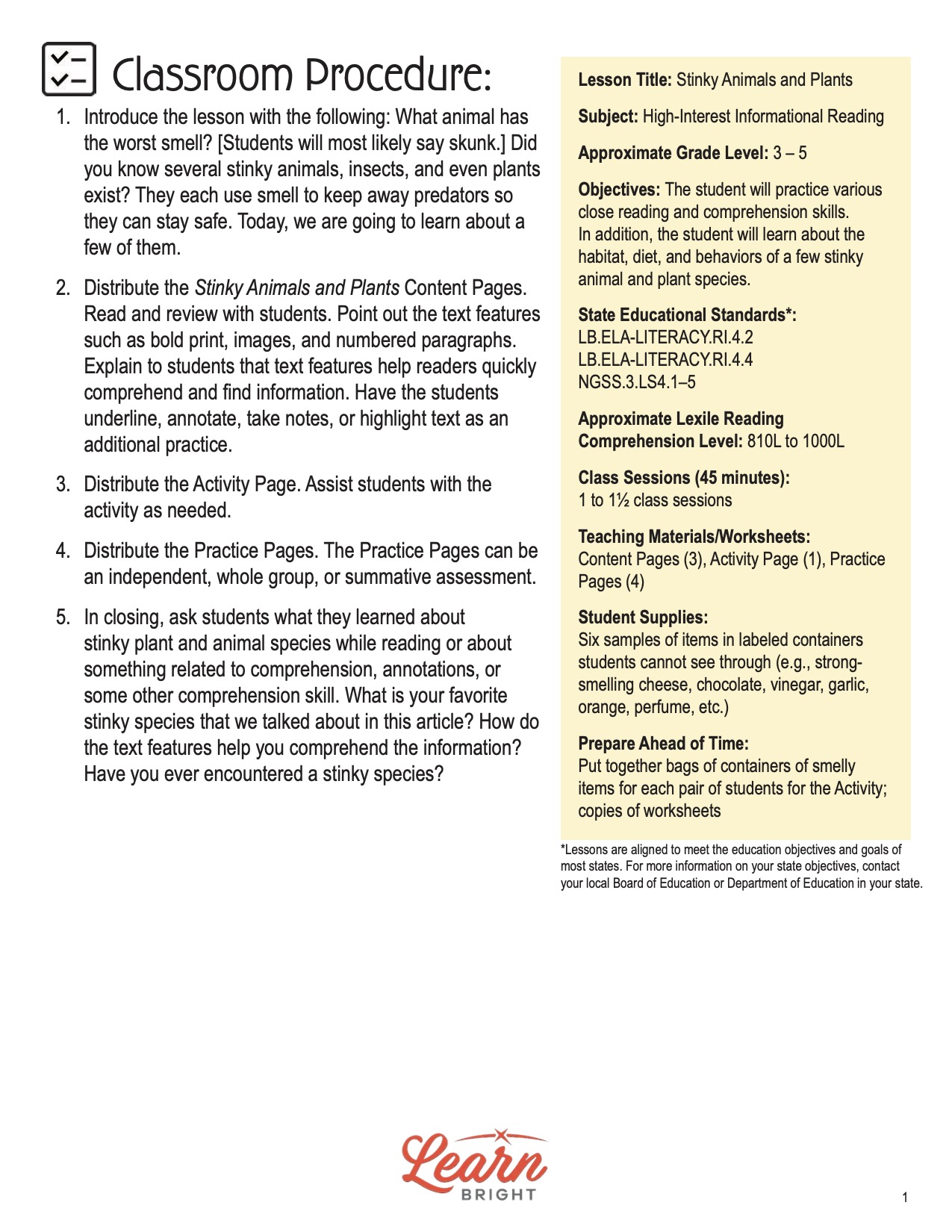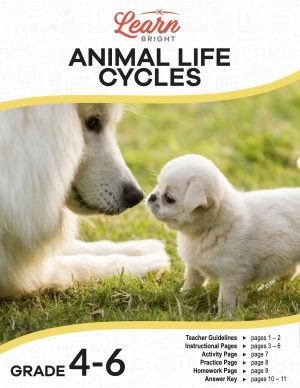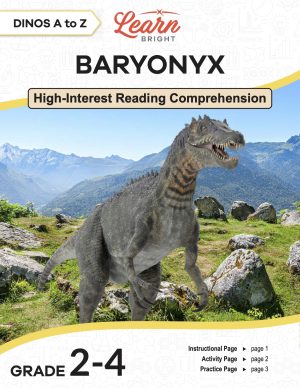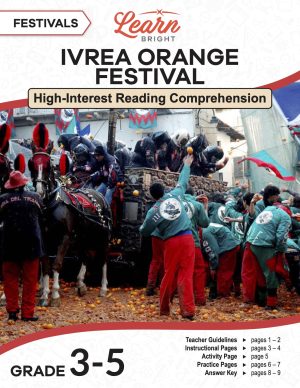Description
What our Stinky Animals and Plants lesson plan includes
Lesson Objectives and Overview: Stinky Animals and Plants is a high-interest reading comprehension lesson plan. As such, students will practice various close reading and comprehension skills. In addition, they will learn about the habitat, diet, and behaviors of some smelly species. This lesson is for students in 3rd grade, 4th grade, and 5th grade.
Classroom Procedure
Every lesson plan provides you with a classroom procedure page that outlines a step-by-step guide to follow. You do not have to follow the guide exactly. The guide helps you organize the lesson and details when to hand out worksheets. It also lists information in the yellow box that you might find useful. You will find the lesson objectives, state standards, and number of class sessions the lesson should take to complete in this area. In addition, it describes the supplies you will need as well as what and how you need to prepare beforehand. This lesson does require some prep ahead of time. Also check the student supplies section for a list of supplies.
Teacher Notes
The paragraph on this page gives you a little more information on the lesson overall and describes what you may want to focus your teaching on. It explains that you can teach this lesson in a whole-class setting or as an independent, small-group activity. The blank lines are available for you to write out any thoughts or ideas you have as you prepare.
STINKY ANIMALS AND PLANTS LESSON PLAN CONTENT PAGES
Stinky Animals
The Stinky Animals and Plants lesson plan contains three content pages. The first one-and-a-half pages focus on stinky animals: the bombardier beetle, the stink bug, and the marbled polecat.
Bombardier Beetle
The bombardier beetle is a small insect with a shiny black or dark-brown body, a red or dark-orange head, and a hard shell. Some species have green ridged wings, depending on their habitat. What makes it unique is that it can spray a hot, stinky liquid from the tip of its abdomen when it feels threatened. The liquid can reach temperatures close to boiling! And, of course, it smells awful. Bombardier beetles have precise control over releasing their spray and can aim it accurately at their enemies. The smell helps scare away predators like birds or other insects that might want to eat them. These smelly bugs usually live on the ground in forests or fields where they can find food to eat, including small insects and plants.
Bombardier beetles also produce audible sounds as part of their defensive strategy. When threatened, some species of bombardier beetles can create noises by rapidly expelling air through their spiracles, which are tiny holes along their abdomen. This sound—pop, click, pop—is an additional deterrent to predators, signaling that the beetle is prepared to defend itself. Combined with their chemical spray, this auditory defense mechanism tells predators to stay far away.
Stink Bug and Marbled Polecat
Stink bugs are small insects with shield-shaped bodies in different colors—brown, green, or gray. They have sucking mouth parts that they use to eat plant sap. Stink bugs can change their color slightly to blend in with their surroundings. This adaptation, known as cryptic coloration, helps them avoid being detected by predators.
These bugs also use their stinky smell as a defense mechanism. When they feel threatened, they release a strong, pungent odor from glands in their thorax. This smell helps protect them from predators like birds and lizards. You can find stink bugs in gardens, around farms, and even inside homes during the colder months. They like to feed on fruits, vegetables, and flowers.
A marbled polecat is a small mammal related to weasels and skunks. It has a long, slender body with short legs and a bushy tail. Its fur is light brown with darker marbled patterns, which helps it blend in to its surroundings. When they feel threatened, marbled polecats hiss, shriek, bare their teeth, stand their fur on end, and arch their backs. And if none of those defenses work, they release a strong, musky odor from scent glands near their tail. This smell wards off predators like foxes and eagles. And if even that doesn’t work, they will just play dead.
Marbled polecats live in dry, open habitats, including deserts, steppes, and grasslands, across Asia and Eastern Europe. They are nocturnal (active at night) and feed on small animals like rodents, birds, and insects. One interesting thing about marbled polecats is that they are solitary animals that prefer to live and hunt alone, except during the breeding season.
Corpse Flower and Western Skunk Cabbage
The corpse flower is a giant plant native to rainforests of Indonesia. It got this name because it releases a strong smell similar to rotting meat when it blooms! Despite its stinky odor, many people come to see it because it’s one of the largest flowers in the world, growing up to 10 feet tall. The corpse flower has a large, purple-colored spadix (a spike-like structure) surrounded by a deep red or maroon-colored spathe (a petal-like structure). The unusual flower attracts insects like beetles and flies that help pollinate it.
Beyond its notorious smell, the corpse flower has another intriguing characteristic—its infrequent blooming schedule. It can take up to 7 to 10 years or more for a corpse flower to bloom again after its first bloom. The long dormancy, followed by a rare and brief blooming event, makes seeing a corpse flower in full bloom a memorable experience for botanists and plant enthusiasts.
The western skunk cabbage grows in the damp, shady swamps of the Pacific Northwest. It has big, green leaves that look like they are made of rubber. In fact, the leaves can sometimes reach up to three feet long. In the early spring, the skunk cabbage produces a strange-looking flower that is shaped like a purple hood. The flower smells bad, kind of like rotten meat. But the scent attracts pollinating bugs that help the plant grow.
One cool thing about this plant is that it can actually make its own heat! It’s blooming stem gets hot when the flower blooms. The heat melts surrounding snow and ice to give pollinators easy access to the plant. As another fun fact, bears often eat the skunk cabbage after hibernation because it helps them poop! The fibrous leaves and other plant materials in skunk cabbage can help get their digestive systems back in working order.
Why They’re Important
All plants, animals, and insects play a role in the environment, even if they don’t smell so great! These species each play important roles in their respective ecosystems. Bombardier beetles help control insect populations by deterring predators with their hot, noxious spray, thus protecting plants from excessive pest damage.
Stink bugs contribute to the balance of the ecosystem by feeding on plant pests and serving as prey for other animals. The corpse flower attracts pollinators with its foul odor, promoting plant reproduction and supporting rainforest biodiversity. Marbled polecats help maintain prey populations to prevent habitat degradation and contribute to nutrient cycling. All this helps maintain the health and stability of their ecosystems.
STINKY ANIMALS AND PLANTS LESSON PLAN WORKSHEETS
The Stinky Animals and Plants lesson plan includes two worksheets: an activity worksheet and a practice worksheet. Each one will help students solidify their grasp of the material they learned throughout the lesson. You can refer to the classroom procedure guidelines to know when to hand out each worksheet.
WHAT’S THAT SMELL? ACTIVITY WORKSHEET
With a partner, students will take turns identifying and ranking six items from a bag that you provide. First, Partner 1 will be blindfolded. They will pull out each item in its container from the bag and smell it. For each item, they will say what they think the item is and then rank how good or bad the smell is as Partner 2 marks (circles) Partner 1’s choices in the chart on their activity page.
When they finish with all six items, partners will switch. Partner 2 will be blindfolded and identify/rank the items as Partner 1 fills in Partner 2’s choices on their activity page.
PRACTICE WORKSHEET
The practice worksheet requires students to answer a series of 10 questions. These questions all relate to the content pages, so students will need to refer to them often for the answers. In addition, each question provides which reading tool the question corresponds to, such as text feature, vocabulary, or comprehension.
Worksheet Answer Keys
At the end of the lesson plan document is an answer key for the practice worksheet. The correct answers are all in red to make it easier for you to compare them with students’ responses. If you choose to administer the lesson pages to your students via PDF, you will need to save a new file that omits these pages. Otherwise, you can simply print out the applicable pages and keep these as reference for yourself when grading assignments.









